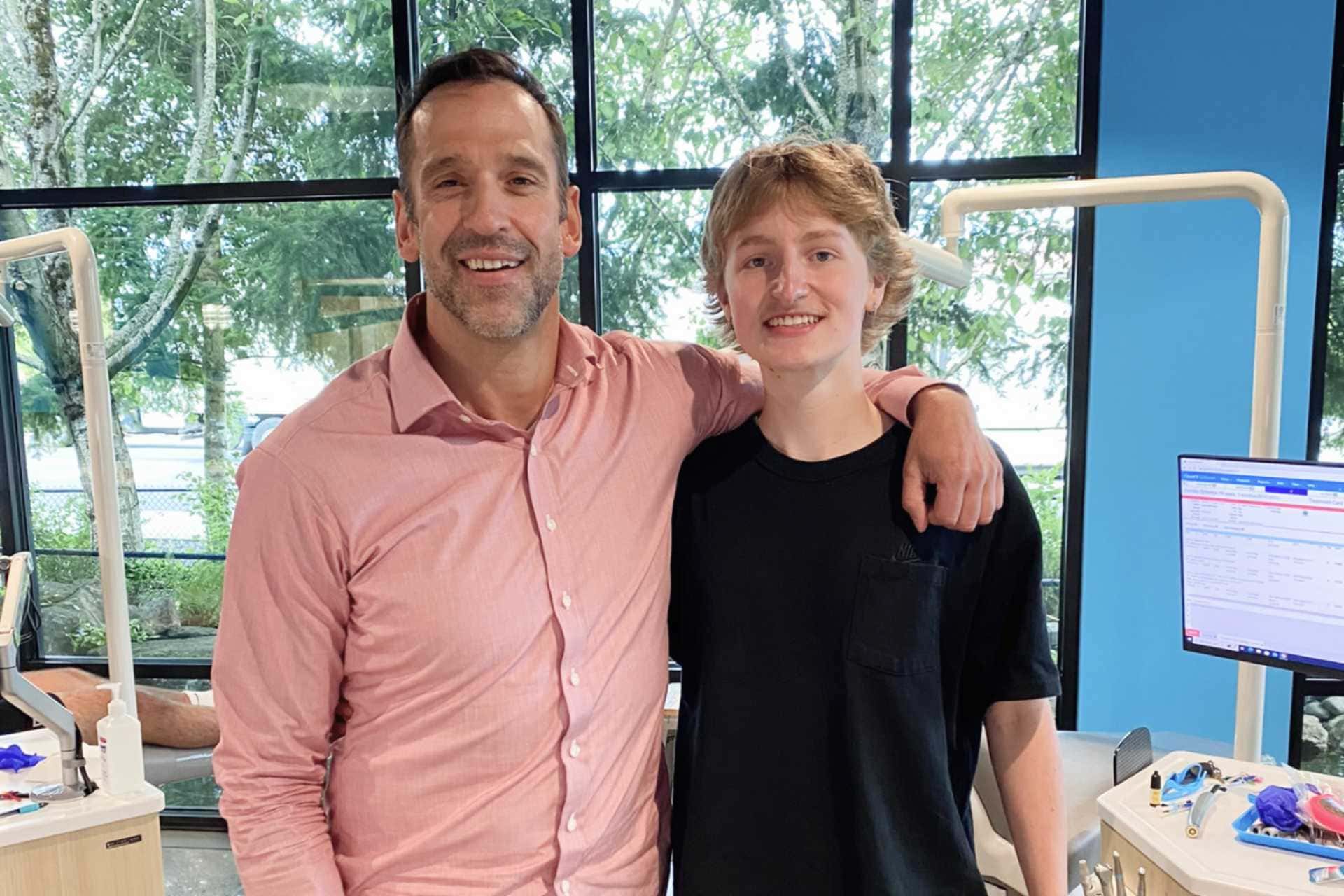Phase 1 Treatment
Navigating the world of parenting often feels like charting unknown territory. One moment you’re discussing baby teeth and the next, your conversations with fellow parents are filled with words like ‘braces’ and ‘aligners’. It’s easy to assume that orthodontic care is a teenage rite of passage, but you might be surprised to learn that early intervention can pave the way for smoother orthodontic journeys. At Senestraro Family Orthodontics, we’re passionate about enlightening parents on the benefits of early orthodontics.
The Power of Early Orthodontic Care
If your little one’s teeth seem to be playing a game of Twister in their mouth or you’re concerned about their bite, an orthodontic checkup could be beneficial. The American Association of Orthodontics endorses that children who may have orthodontic issues should consult an orthodontist by age 7. This age often presents a mix of baby and permanent teeth, offering us a perfect window to identify any potential challenges with their teeth or bite.
Wondering what happens when you step into our office? We’ll conduct a thorough examination of your child’s bite, teeth, and jaw alignment. From identifying the effects of thumb sucking to spotting overlapping teeth, our state-of-the-art digital technology makes orthodontic exams a breeze. So, you can sit back and relax while we ensure your child’s smile is on the right track.
The Benefits of Phase 1 Orthodontic Treatment
Phase 1 Orthodontic Treatment, also known as early treatment, typically begins when a child still has a mix of primary and permanent teeth, usually around ages 6 to 10. This proactive approach allows us to correct and guide the growth of your child’s jaw, create more space for crowded teeth, and avoid the need for tooth extractions later on. By addressing these issues early on, we can significantly reduce the length and complexity of future treatments.
Why Choose Early Treatment?
Experience has taught us that catching orthodontic issues early can prevent them from snowballing into bigger problems. Let’s say your child has an upper jaw that’s outgrowing the lower one. We would gently guide the growth of the upper jaw using a specially designed appliance. With each visit, we’d adjust the appliance, ensuring the upper jaw aligns harmoniously with the lower one over time. This early intervention could potentially save your child from more invasive procedures, such as jaw surgery, as they grow older.
Orthodontic appliances are often used in childhood to gradually move teeth and adjust jaw positions. Alongside the use of appliances, there may be instances where a tooth needs to be removed to make room for incoming permanent teeth.
Curious about early orthodontics or have questions about your child’s teeth or bite? Contact our team today to request a free consultation for your child.
Airway Orthodontics
At Senestraro Family Orthodontics, we understand that orthodontic care is not just about straightening teeth. It’s about enhancing overall health, and that includes the ability to breathe easily and sleep well. That’s why we are proud to offer Airway Orthodontics, an innovative approach to treating airway issues with orthodontics.
What is Airway Orthodontics?
Airway Orthodontics is a specialized field of orthodontic care that focuses on the relationship between oral health and breathing. The primary goal is to ensure the patient has an optimal airway, which can help alleviate issues such as sleep apnea, chronic mouth breathing, and other sleep-related disorders.
By considering the size, shape, and positioning of the jaw, teeth, and tongue, we aim to improve the structure of the oral cavity and enhance the patient’s ability to breathe naturally through their nose, ultimately promoting better sleep and overall health.
Why is Airway Orthodontics Important?
A properly functioning airway is crucial to our well-being. When there are obstructions or misalignments in the oral and nasal structures, it can lead to difficulty breathing, especially during sleep. This can result in conditions like sleep apnea, which is characterized by repeated pauses in breathing throughout the night, leading to disrupted sleep and potential health risks.
Children with airway issues may experience problems such as mouth breathing, snoring, restless sleep, and behavioral issues. In adults, poor airway health can lead to chronic fatigue, poor concentration, and an increased risk of cardiovascular diseases.
How Does Airway Orthodontics Work?
At Senestraro Family Orthodontics, our approach to Airway Orthodontics involves a thorough examination of your or your child’s facial structure, teeth alignment, and breathing patterns. We use state-of-the-art diagnostic tools to identify any potential issues and develop a personalized treatment plan.
Treatment may involve traditional orthodontic methods, such as braces or aligners, along with other therapies like myofunctional therapy (exercises to improve the function of facial muscles and promote nasal breathing) or the use of oral appliances designed to open up the airway.
In some cases, early intervention in children can guide jaw development and improve airway function, reducing the risk of sleep disorders later in life.
Whether you’re concerned about your child’s breathing or your own sleep quality, Airway Orthodontics may provide the solution you’re looking for. At Senestraro Family Orthodontics, we’re committed to helping our patients achieve not only beautiful smiles but also healthier lives.
If you have any questions about Airway Orthodontics or would like to request a consultation, please don’t hesitate to contact us. Let us help you breathe easy and sleep well.
Orthognathic (Jaw) Surgery
Our jaw is perhaps the most overlooked aspect of our oral health. If you suffer from jaw-related problems, you may qualify for orthognathic surgery. Orthognathic, or corrective jaw surgery, typically addresses the intricacies of occlusion (the way your teeth fit together).
There are a number of reasons you may need orthognathic surgery, with many variations on the procedure. At Senestraro Family Orthodontics, we will be able to determine if you are a candidate for corrective jaw surgery. Surgical intervention may be the best way to alleviate severe, and often painful symptoms related to jaw disorders.
Reasons For Orthognathic Surgery
There are many patients who can benefit from orthognathic surgery, especially those with TMD or a malocclusion otherwise known as a misaligned bite. We may recommend jaw surgery to:
- Correct problems with speech
- Correct problems that affect chewing or swallowing
- Correct issues that occur when you open or close your mouth
- Correct a facial imbalance for cosmetic and functional reasons
- Address birth defects or abnormalities
- Minimize the problems associated with bruxism (clenching or teeth grinding)
- Minimize problems associated with TMD (temporomandibular joint disorder)
- Repair a facial injury or trauma
- Alleviate the symptoms of obstructive sleep apnea
Corrective jaw surgery is usually only recommended when orthodontic treatment alone is unable to get you an ideal result. As part of your free consultation appointment, Dr. Seth will perform a series of diagnostic tests to determine if orthognathic surgery is right for you. This is an excellent opportunity for you to ask questions and discuss orthognathic surgery options and alternatives.
Many patients seek orthognathic surgery for purely aesthetic reasons and not necessarily to correct their bite. That being said if your jaws are out of place causing facial imbalance or asymmetry your bite is likely off as well. The most common request for esthetic improvement reported by men seeking jaw surgery is a receded or small lower jaw making them appear less maculine. Conversely, women commonly seek facial balance through jaw surgery because they look masculine due to a lower jaw that is too far forward. Other asymmetries and height issues such as gummy smile can also be corrected with jaw surgery and braces.
Preparing For Surgery
Orthodontic treatment is a large part of the preparation for corrective jaw surgery. Dr. Seth has excellent communication with the oral surgeons as they work as a team to plan your surgical and orthodontic treatment, this cooperation is vital to the success of your treatment. Braces are used to align your teeth allowing the oral surgeon to move your jaws to their ideal position during surgery. After the surgery elastic bands are worn from the top to bottom braces to stabilize your surgical result. The braces are usually in place for about 12 to 18 months before your surgery. Braces are usually on for another 6 months after surgery as Dr. Seth gets all the details perfect.
X-rays and 3D CBCT scans are also an important part of the preparation process. These diagnostic tools help us develop a more precise and appropriate treatment plan. In particular, 3D imaging can help us design a surgical guide that results in safer and more effective surgery. At Senestraro Family Orthodontics we will do a complimentary 3D x-ray scan to help you make an informed decision on whether jaw surgery is the the best option for you.
Types Of Orthognathic Surgery
In most cases, the surgery is performed inside your oral cavity to avoid facial scars around your chin, jaw, and mouth. The type of orthognathic surgery you receive depends on your symptoms. Types of corrective jaw surgery include:
- Lower Jaw — Also known as a mandibular osteotomy or Bilateral Sagittal Split Osteotomy (BSSO) is the most common type of surgery that can help correct a receding or protruding lower jaw.
- Upper Jaw — Also known as maxillary osteotomy or le fort osteotomy is a type of surgery that can correct open bites, cross bites, or a significantly narrow, protruding, or receded upper jaw.
- Chin Surgery — Also known as a genioplasty, this type of surgery can correct a deficient chin, usually accompanied by a severely receded lower jaw.
After Orthognathic Surgery
After your orthognathic surgery, you should see the improved function of your teeth, a balanced facial appearance, and several other health benefits that improve chewing, swallowing, sleeping, and breathing. Be sure to follow our post-operative instructions to avoid potential complications.
The healing period for orthognathic surgery typically takes about 6 to 12 weeks. We usually recommend avoiding tobacco use, difficult foods, and strenuous activity. Talk with Dr. Seth to learn more about life after corrective jaw surgery.





